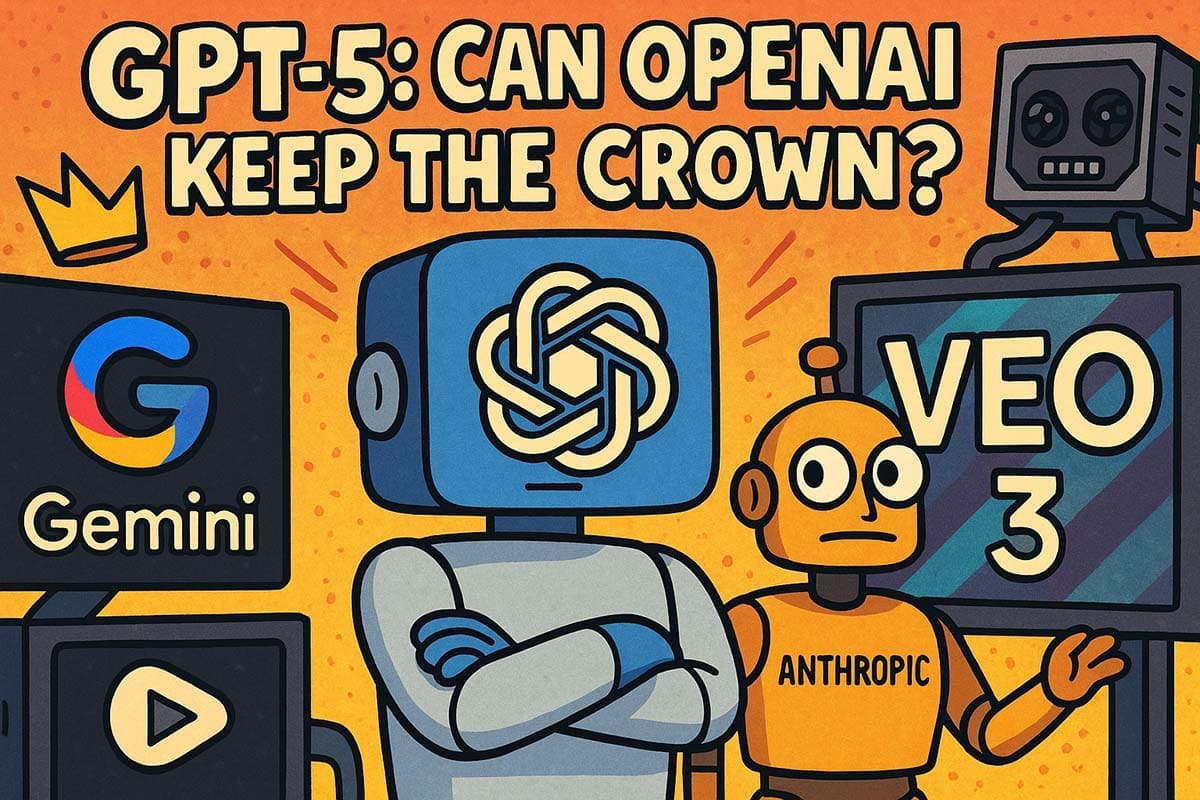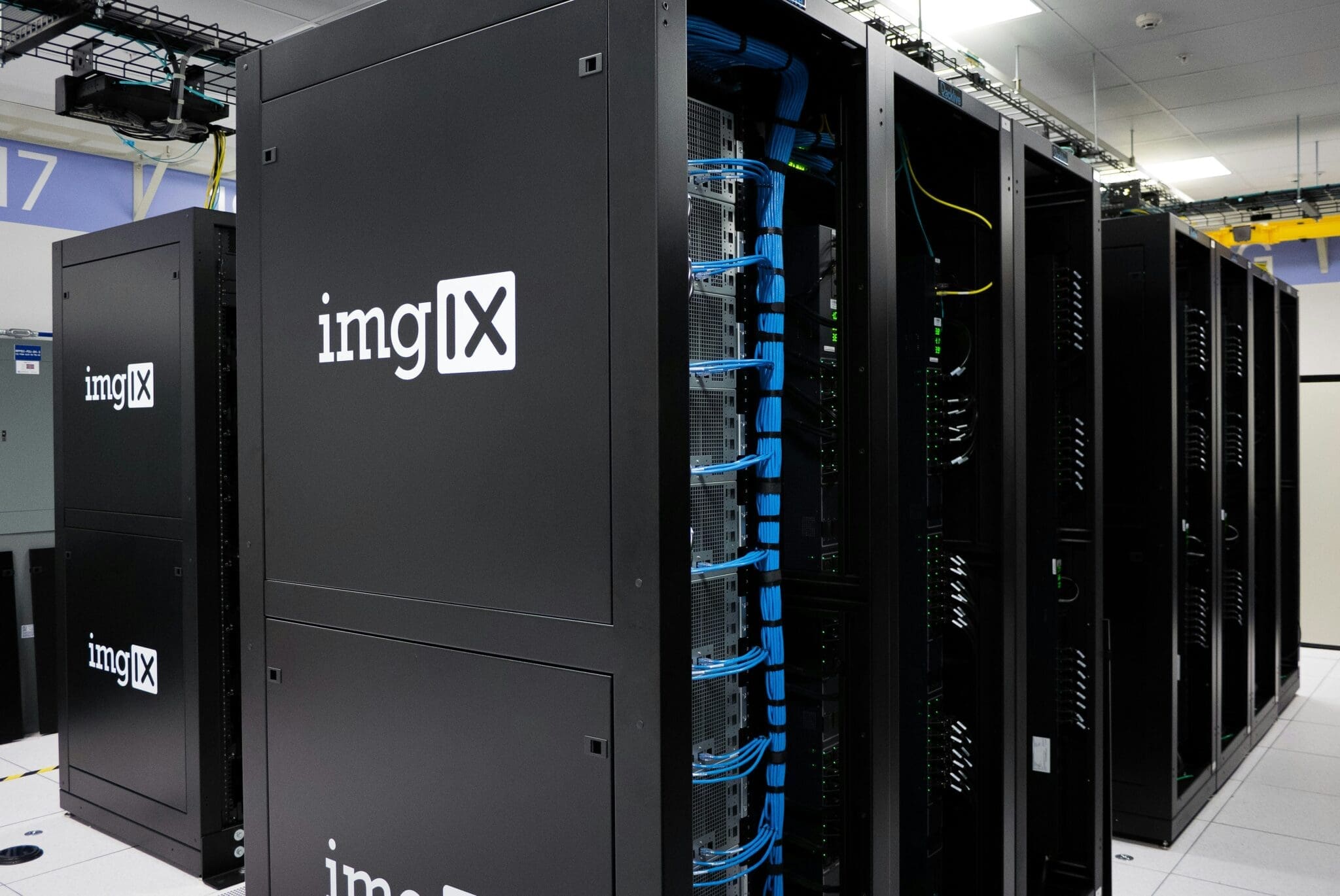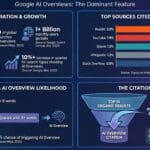Things are heating up in the world of AI, LLMs and especially image/video generation models. We have seen incredible progress with Google’s Gemini, Google Opal for building AI apps, and video generation tools, such as VEO 3, which produces jaw-dropping results that can even rival industry-leading CGI studios. Anthropic’s Claude Sonnet 4 and Opus 4 lead the way in advanced reasoning, coding accuracy, and agent-like task performance.
The Large Language Model battle is well underway, but what is GPT-5, what does OpenAI need to do to keep the crown, and what can we expect from them in the coming months?

OpenAI GPT-5: Will OpenAI keep the crown?
- 1 When is GPT-5 being released?
- 2 GPT-OSS you say?
- 3 What went wrong with the GPT 4.5 update
- 4 What about GPT-4.1
- 5 Full timeline of OpenAI models after GPT-4
- 6 What is GPT5 and what would we like to see?
- 7 What we can expect from GPT-5
- 8 Will we get AGI with GPT‑5?
- 9 Final thoughts: Will ChatGPT 5.0 meet expectations?
When is GPT-5 being released?
Although no official release date has been announced, the initial release of the GPT-5 was rumoured to be sometime during August but is now looking more likely to be late August to September 2025. This may include variations of the model, like how we currently use GPT-o4 mini or GPT-o3 pro, but nothing has been confirmed at the time of writing.
GPT-OSS you say?
In the meantime it seems, OpenAI have decided to focus on other initiatives like GPT‑OSS, a new family of open-weight language models (gpt‑oss‑120B and gpt‑oss‑20B) available under the Apache 2.0 licence. For the first time, this makes it possible for developers and researchers to download, run, inspect, and fine-tune them locally, marking the company’s first open-weight model release since GPT‑2. Read more on this here.
What went wrong with the GPT 4.5 update
Before we discuss GPT-5 and note features we hope to see, let’s look at the GPT-4.5 release, which many view as a stumbling block compared to OpenAI’s previous models.
GPT‑4.5 (codenamed Orion) was officially released as a research preview on 27 February 2025, available first to ChatGPT Pro users and then rolled out to others.
While GPT-4.5 was fine, it wasn’t the upgrade users hoped for. Many improvements seemed superficial and didn’t significantly improve functionality, such as reasoning and puzzle-solving. The update was more of a polishing-up release that improved the perceived realism of the responses without addressing and improving deeper functionality.
In many ways, people felt 4.5 was a downgrade, with users reporting issues with multistep reasoning and analytical thinking. Perhaps this decision was intentional, focusing on superficial elements of the large language model that impress users, or features that are more glamorous for marketing purposes.
The improved human-sounding replies may sound impressive, but it doesn’t mean much if they are incorrect or misleading.
What about GPT-4.1
To add to the confusion, OpenAI surprised everybody who expected GPT-5 to be the next logical step after GPT-4.5
Then came GPT‑4.1, which included GPT‑4.1, Mini and Nano variants, which was introduced later on 14 April 2025 via the OpenAI API, and gradually became available in ChatGPT by mid‑May .
We’ve gone from GPT‑4 → GPT‑4o → GPT‑4.5 (Orion) → GPT‑4.1 family → o3 / o4‑mini → GPT‑OSS, surely the next model will be GPT-5?
See below for a full timeline of models post the GPT-4.
Full timeline of OpenAI models after GPT-4
- GPT‑4o (Omni) – released May 13, 2024. A multimodal model capable of handling text, image and audio, and powering Advanced Voice Mode. Context window up to 128K tokens.
- GPT‑4o‑mini – introduced in July 2024, a compact and cost‑efficient version that replaced GPT‑3.5 Turbo in ChatGPT.
- o1-series – launching as a reasoning-first model aimed at complex tasks. Released full o1 on 5 December 2024, having earlier preview components like o1-mini, o1-pro.
- GPT‑4.5 (Orion) – released 27 February 2025 as OpenAI’s largest GPT to date, focused on scale and fluency. While powerful, it is not designed as a reasoning model. It served as a stopgap before broader upgrades.
- GPT‑4.1 family (4.1, Mini, Nano) – rolled out on 14 April 2025, available via API and ChatGPT from mid‑May. Offers massive context windows (up to 1 million tokens), excellent coding performance, and lower cost than GPT‑4o. Later replaced GPT‑4o in ChatGPT.
- o3 and o4‑mini – deployed on 16 April 2025, emphasising deep reasoning, tool use, and efficient multimodal processing. The o4‑mini‑high variant adds more reasoning depth.
- GPT‑OSS (gpt‑oss‑120b & gpt‑oss‑20b) – launched 5 August 2025 as OpenAI’s first open‑weight models since GPT‑2. These are downloadable under Apache 2.0, match o4‑mini performance, and even run on smartphones (20B version) or single GPUs (120B).
What is GPT5 and what would we like to see?
For those wondering, “What is GPT-5?”, the answer is, nobody really knows for sure other than OpenAI themselves.
There’s no shortage of feature requests from users online, asking for improvements to deeper reasoning and impressive features. But not so fast, let’s first address the most problematic areas of the current models and see what longstanding problems must be fixed before adding complexity and new features.
Improved accuracy
It’s not sexy or glamorous, it’s just fundamental.
Having the most realistic-sounding AI is useless if the information in the responses is wrong. Accurate responses should be a top priority for OpenAI when developing its new model.
Here’s an anecdote about my recent experiences with the current models available from OpenAI. I recently used GPT-4o to perform a simple calculation to save using the calculator app on my phone. After all, it’s a simple task, and I wanted to be efficient as the tab was already open.
The task was simple: “Add these numbers together and give me the answer”.
Using ChatGPT-4o, the answer it gave me was wrong. This has only ever happened once, but it was enough to shake my confidence in GPT, especially when touted as an intelligent AI that isn’t lightyears away from AGI. It feels as if the latest GPT models can talk the talk and be convincing in many cases, but still are susceptible to hallucinations and fumbling with basic questions.
We would like to see further improvements when handling more complex reasoning tasks, and a broader understanding of what the user is trying to achieve with their requests.
Feature and model consolidation
Does anyone else feel confused when trying to decide what model to use? Just look at the long and confusing timeline above, it’s no wonder general users struggle.
It seems silly, but choosing the model — each of which has its benefits — seems like an unnecessary step for users. You mean ChatGPT can explain complex concepts but can’t decide which model best suits my query? Then we have the separation of DALL-E, image generation using GPT-4o, and Sora; it would make sense to unify all these services under the GPT umbrella, integrating everything into a single ChatGPT 5.
I’m not just talking about multimodal features becoming streamlined into one, but unifying the various options such as o3, o4, o4-mini, etc.
Right now, it’s messy. It can be confusing even for seasoned GPT users looking to get the most out of the service.
Long-term memory
There are several ways that ChatGPT-5 should improve long-term memory. The new model’s memory should improve on the existing functionality of remembering statements across topics, but more importantly, it should remember the entire thread of any conversation rather than snippets.
This is particularly crucial when working with code: how frequently have you tried to use GPT for coding, only to have it truncate and remove sections while gaslighting you into thinking those sections never existed? It can be humorous at first, but quickly becomes frustrating and can ruin projects when using the current models for complex tasks such as programming.
This ties into contextual awareness and language understanding, forming a comprehensive grasp of the goal you seek to achieve and any prerequisites crucial to the task.
- Project-specific memory: Every project is different and sometimes requires unorthodox techniques you may not want for subsequent projects. A reliable and context-aware project-specific memory would help improve model satisfaction and productivity.
- Adaptive personalisation: Everyone has their own writing and coding style. GPT models of the future, including GPT 5, should better understand and remember the nuances of each style and adapt accordingly to better integrate with collaborative projects.
- Improved memory management: Give us the tools required to manage how GPT handles memories of our project, styles, and preferences. For example, train the models to work in line with your brand’s voice to better help in press releases and promotions without the need to cover this with every interaction or project.
Tone and personality
Providing a dedicated configurable dashboard for tone and personality would save time and be ideal for those who use ChatGPT for work and personal life.
Presets and sliders we can adjust to determine the tone we are looking for would go a long way in assisting with tasks that require personality, producing human-like responses via text and speech.
Fewer limits for paying subscribers
Paying a monthly fee to access the latest and greatest from OpenAI, only to be met with a message telling you to wait a month until your “limit” resets, is frustrating.
Having a project that is reliant on an AI system for assistance that must be put on hold halfway through development seems poor if we are to take these models seriously and have them as integral parts of our workflow. If GPT is meant to be an always-on creative partner, it must be there when it counts and not disappear behind a digital paywall reset timer due to overuse.
Hopefully, with improved optimisation and revamped architecture, there will be less need to limit prompts on the high-end versions of the latest releases.
Medical and scientific research
This is more of a hope for broader use than a feature request, but harnessing AI capabilities to push medical and scientific research should be strongly encouraged. We have seen great progress with using LLMs to help with medical research and disease analysis.

LLMs can help medical research. Photo by Louis Reed on Unsplash
Studies that evaluate the potential of using GPT models in medical research have been carried out using previous models of ChatGPT, resulting in the following conclusion.
“ChatGPT has the potential to revolutionize medical research in various ways. However, its accuracy, originality, academic integrity, and ethical issues must be thoroughly discussed and improved before its widespread implementation in clinical research and medical practice.”
(posted 28 March 2023) — Suebsarn Ruksakulpiwat, Department of Medical Nursing
Perhaps with a newer model that is less prone to hallucinations, ChatGPT and large language models can play a bigger part in disease research. LLMs are great at pattern recognition and data analysis, so there are many situations where such technology could be used by doctors, medical professionals, and scientists.
What we can expect from GPT-5
There’s always a lot of speculation leading up to new GPT models, and this time is no different.
After 4.5 arguably being a let-down in the eyes of the users, and competition becoming increasingly popular, OpenAI needs to impress with their release of GPT-5.
So, what can we realistically expect from ChatGPT 5 based on rumours, leaks, and statements? We’ve rounded up a consensus based on existing data and predictions. Here are our GPT-5 predictions based on what we know so far at the start of August 2025.
GPT-4 vs GPT-5 (Speculative) Comparison
| Feature | GPT-4 | GPT-5 (Speculative) | Sources |
| Parameters | ~1 trillion | 1.5 trillion + | Ascend |
| Hallucination Rate | ~10-15% (speculative) | <5% | Addepto |
| Reasoning Accuracy | ~85% | 95%+ | Predicted |
| Token Limit | 8,000 – 32,000 | 64,000 – 256,000 | Toolify |
| Multimodal Capability | Text, Image input (limited) | Full multimodal | Predicted |
| Response Time | ~1-2 seconds | <1 second | Predicted |
Data is speculative based on rumour, interviews, and analysis from third-party websites.
Some of our predictions are made following the recent Sam Altman appearance on comedian Theo Von’s podcast.
Sam Altman | This Past Weekend w/ Theo Von #599
There are some interesting comments here from Sam Altman, hinting at several features that are likely to make it into GPT-5, and a possible release date timeframe.
Some noteworthy points lead us to believe that GPT-5 isn’t far away and will include some long-requested features and enhanced capabilities. He shares several personal stories, one stating how this new model made him stop in his tracks, realising that the model knew way more than he did about a niche topic. Whether this is marketing and hype remains to be seen.
Memory management
Sam Altman has hinted at the possibility that GPT-5 identifies the user’s personality from persistent use, making the model feel more natural in how it adapts to personal taste and preferences. Persistent memory that doesn’t require manual prompts and reminders was also hinted at in the recent interview.
Tone tuning
Instead of the convoluted model selection menu, we may be seeing a dashboard to fine-tune the model’s tone. Whether you need academic assistance with a project or some conversational suggestions for a wedding speech, control over tone will mean the model is working within a more refined context, improving the output.
Educational improvements
The system we currently have for education worldwide is somewhat antiquated. Utilising the same techniques for broad subsets of unique individuals isn’t the most effective solution when educating large numbers of people. Additionally, remembering facts and being tested on how effectively we remember them isn’t the best way to judge intelligence or expertise.
Using upcoming AI models such as GPT-5 will identify the learning style of everyone and assist based on whether the student is a visual or an aural learner. Not just text, but via video and audio, which means quicker, more effective teaching. This will also be combined with an emphasis on critical thinking and logical reasoning, aiding individuals to form opinions rather than inherit them blindly from third-party sources.
Collaborative approach
Various hints point towards future AI models aiming to occupy more of an assistant approach rather than being left to work autonomously.
It’s hard to think that OpenAI will be limiting its model’s capability, but in terms of getting the most out of the future LLM models, expect a focus on having GPT models working with, not for, human users when it comes to creativity. For creative projects, OpenAI wants its AI models to work with human intelligence, not replace it.
Architectural improvements
Despite not having a huge impact on functionality, this is a big one.
It’s no secret that LLMs consume water at a mind-blowing rate due to heat. Businesses are trying to harness the heat generated from data centres in various ways, such as for agricultural processes.
In upcoming GPT models, including GPT-5, we can expect an efficient “Mixture-of-Experts” (MoE) approach, similar to how DeepSeek works. This system increases efficiency by activating specific sections of the model at a time rather than every part of the model at once. This still allows for more complex tasks to be achieved, only by the right parts of the model that are best suited for the query.
Think of it like this. MoE, as a concept, is like walking into a hospital. You don’t get seen by every doctor once you arrive; you’re directed to the neurologist if it’s a brain issue, or the orthopaedic if a knee issue. This process is efficient, targeted, and avoids unnecessary work.
Will we get AGI with GPT‑5?
The idea that OpenAI might deliver the first publicly recognised AGI (Artificial General Intelligence) with GPT‑5 is widely debated.
Back in September 2024, we posted discussed the “o1” model as a potential inflection point towards AGI.
Reducing the amount of work per request reduces strain on the servers. This means less heat and water usage as a result.
Brilliance, Betrayal & Building Tomorrow: The History of OpenAI & Its Future (AGI) [UPDATED]
In the article below, we discussed how breakthroughs such as Q* were significant steps towards achieving AGI.
The wider issue is that AGI lacks a firm, universal definition, making it difficult to know exactly when or if we’ve reached it.
Even Microsoft and OpenAI reportedly disagree on what constitutes AGI, with some measures tied arbitrarily to profit benchmarks like reaching $100 billion in revenue — the goalposts keep shifting.
So will GPT‑5 be the milestone that finally crosses the threshold?
It’s possible. If GPT‑5 succeeds in combining deep reasoning, extended memory, architecture optimisation, autonomous tool use and truly robust multimodal abilities, while dramatically reducing hallucinations, it may push us into new territory. But it may still fall short of the broad cognitive flexibility most experts say is required for true AGI.
What’s clear is that we’re getting closer, but GPT‑5 might still be part of a continuum rather than the finishing line.
OpenAI’s roadmap suggests a move toward systems that can adapt across domains intelligently, but whether that equals AGI remains an open question.
Final thoughts: Will ChatGPT 5.0 meet expectations?
What we want from a new GPT model vs what we get may be two different things, but OpenAI must get this release right if they want to keep their place at the front of the pack.
Google VEO 3 has already shown us that OpenAI’s Sora has some fierce competition that far surpasses the video capabilities of current models.
The multimodal capabilities of GPT-5 will be interesting to see. Image generation is impressive and leading the way in its current form, whereas video using Sora for video isn’t even close to Google VEO’s latest offering in terms of the results.
Expectations are always high, particularly after experiencing the “wow factor” that came with the first versions of ChatGPT. We don’t appear to be at the stage of Artificial General Intelligence (AGI) yet, but GPT-5 could be a pivotal moment that moves us closer or perhaps even the event that defines AGI.
What are your thoughts on GPT-5 and its multimodal capabilities? Do you have a prediction on whether GPT-5 will be AGI? Let us know what features you would like to see in upcoming releases from OpenAI in the comments section, or across our social channels.








0 Comments